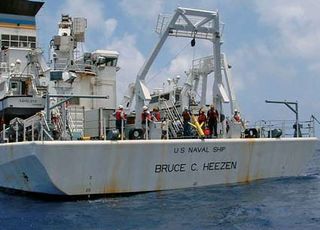"Green" Glider Propelled By Heat Energy In Ocean Water
Woods Hole (MA) - Imagine a watercraft that has no needs for refueling, but simply takes most of its energy needs directly from the temperature differences in Ocean water surrounding the hull. Technically, you will get a transportation device with a virtually unlimited energy resource. It's not science-fiction, but research units are already in operation today.

The Autonomous Systems Laboratory (ASL) of the Woods Hole Oceanographic Institution said it has about 20 "Gods" gliders ("glider operations and data system") in operation today, which use only a minimum of external energy sources. By "harvesting" heat energy from the Ocean, the research units are able to propel themselves "across thousands of kilometers of water."
The basic idea of driving these gliders forward is to increase or decrease its volume without changing its mass. The energy source is drawn through thermal stratification between warm surface waters and colder, deeper layers of the ocean. The researchers said that the heat content of the ocean is enough to warms wax-filled tubes inside the engine, which converts heat into mechanical energy: Oil is then pushed from a bladder inside the vehicle's hull to one outside, changing the glider's buoyancy. Cooling of the wax at depth completes the cycle. Wings generate lift, while a vertical tail fin and rudder allow the vehicles to be steered horizontally.
As a result, the glider creates a saw-tooth pattern through the water. The energy drawn from temperature differences is enough to propel the glider forward, but it was unclear how efficient the approach is. There is enough energy for the "engine" but on-board electrical devices such as a GPS are powered by a battery at this time, limiting the glider's range. The ASL said that a research device has been in use since December 2007 and has crossed the Virgin Islands Basin between St. Thomas and St. Croix (a distance of about 35 miles) more than 20 times. It was unclear at what speed the unit travels. The batteries on board are expected to last for about six months.
In spring, the researchers plan to take a glider on a 900-mile trip from St. Thomas to Bermuda.
So far, these gliders are imagined to become research tools that can work in all weather conditions, carrying a variety of sensors to collect measurements such as temperature, salinity, and biological productivity. Gliders also operate quietly, which makes them ideal for acoustic studies, the ASL said.
Stay on the Cutting Edge
Join the experts who read Tom's Hardware for the inside track on enthusiast PC tech news — and have for over 25 years. We'll send breaking news and in-depth reviews of CPUs, GPUs, AI, maker hardware and more straight to your inbox.
Most Popular


